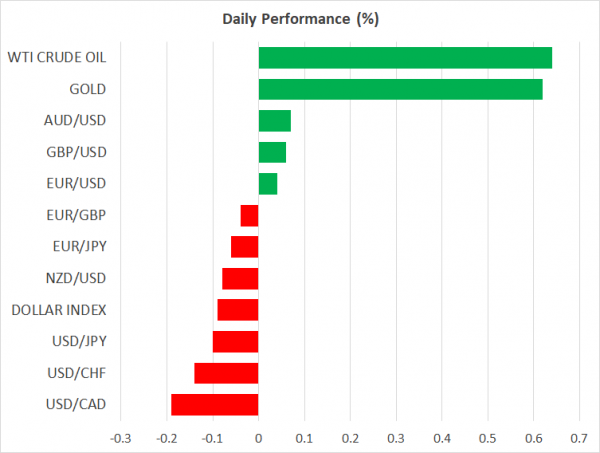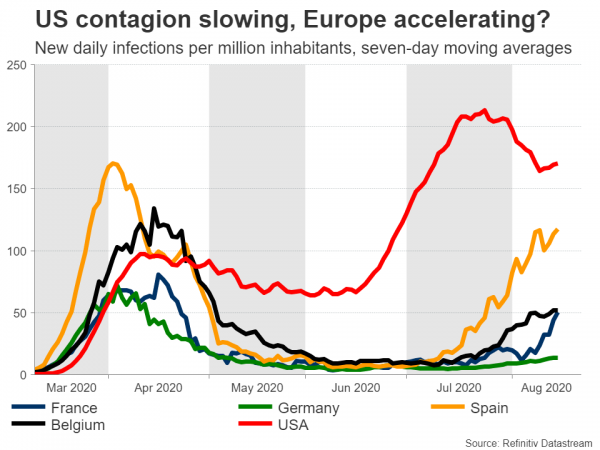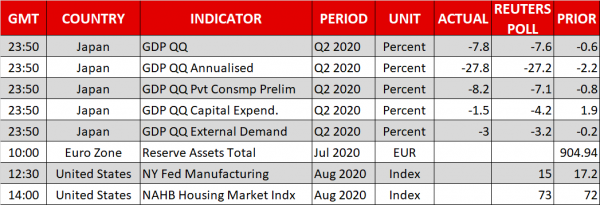- Dollar extends losing streak, yet most FX pairs stuck in narrow ranges
- Will the reversing trend in European/American infections affect euro/dollar?
- US stocks near record highs amid global liquidity tsunami
- Overall, things are calm as investors wait for the next catalyst – Congress?
All quiet on the FX front, except the dollar
The currency market seems to have entered a summer lull, as aside from a modest tumble in the US dollar, there isn’t much else going on in the G10 FX arena. There haven’t been any headlines behind this latest bout of dollar weakness, so it might simply come down to the more optimistic mood in the markets draining demand for the world’s reserve currency, which doubles as a safe haven nowadays.
Euro/dollar is primed to record its fifth consecutive day of gains, approaching the upper end of the range it has been trapped in lately, near $1.19. Technically speaking, it will be crucial to see whether the pair can break above that zone and resume its broader uptrend, as it has been rejected from there twice already.
A third failure to do so may open the door for a meaningful correction, especially when considering that the trend in European/American infections has started to turn. Daily infections in the US are still much higher than Europe, but if one simply looks at the rate of change, America is slowing down while Europe is accelerating again – led by Spain.
Since much of the rally in euro/dollar has been based on the perception that Europe will recover faster than the US, a second infection wave hitting Europe while US numbers stabilize could challenge this entire narrative.
China injects more liquidity, global stocks smile
The reason markets are in a more optimistic mood to start off the new week is likely the new injection of liquidity from China. The nation’s central bank pumped 700 billion yuan into the local banking system on Monday to expedite the economy’s recovery from the crisis.
While the size of this injection is relatively minor, it comes on top of the ocean of stimulus that has been unleashed by the Fed and ECB, so it was enough to put a smile on investors’ faces. China’s Shanghai Composite index rose 2.3%, while futures tracking the S&P 500 point to a 0.3% higher open, with the index now within a whisker of its record high.
Markets may have also breathed a sigh of relief that the meeting between US and Chinese negotiators to review the ‘phase one’ trade deal over the weekend was postponed. Admittedly, there was never much risk of this deal collapsing because Trump needs US farmer votes in key battleground states, so he can’t afford to blow this deal up with an election in 11 weeks. Still, some may have been relieved that another risk passed without materializing.
Looking for a catalyst
In the bigger picture, markets seem to be searching for a new catalyst. Stocks are rising but remain unable to claim new record highs, whereas most currencies appear almost paralyzed, trading without much conviction.
What could shatter this serenity, is the deadlock about a new relief package in Congress. The latest dispute about mail-in ballots and post office funding also seems to have made a compromise less likely. Still, markets seem to be calculating that a deal will arrive soon, because no politician wants to be blamed for wrecking the recovery ahead of an election.
Yet, the negotiations are going nowhere as neither side feels the urgency to compromise, and the longer this impasse lasts, the bigger the risks for the recovery. This begs the question: will markets have to sell off first before politicians feel enough pressure to get a deal done?
The economic calendar is virtually empty today but the rest of the week is more exciting, with the latest FOMC minutes out on Wednesday and the Eurozone’s PMIs on Friday. Brexit negotiations will also resume.















